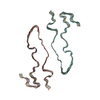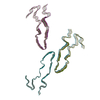+ Open data
Open data
- Basic information
Basic information
| Entry | Database: PDB / ID: 8duw | |||||||||
|---|---|---|---|---|---|---|---|---|---|---|
| Title | HnRNPA2 D290V LCD PM2 | |||||||||
 Components Components | Heterogeneous nuclear ribonucleoproteins A2/B1 | |||||||||
 Keywords Keywords | PROTEIN FIBRIL /  Amyloid Amyloid | |||||||||
| Function / homology |  Function and homology information Function and homology informationpositive regulation of telomerase RNA reverse transcriptase activity / miRNA transport / RNA transport / positive regulation of telomere maintenance via telomere lengthening / G-quadruplex DNA unwinding / primary miRNA processing / G-rich strand telomeric DNA binding / single-stranded telomeric DNA binding / N6-methyladenosine-containing RNA reader activity / miRNA binding ...positive regulation of telomerase RNA reverse transcriptase activity / miRNA transport / RNA transport / positive regulation of telomere maintenance via telomere lengthening / G-quadruplex DNA unwinding / primary miRNA processing / G-rich strand telomeric DNA binding / single-stranded telomeric DNA binding / N6-methyladenosine-containing RNA reader activity / miRNA binding / negative regulation of mRNA splicing, via spliceosome / Processing of Capped Intron-Containing Pre-mRNA / mRNA transport /  Cajal body / mRNA export from nucleus / pre-mRNA intronic binding / catalytic step 2 spliceosome / Gene and protein expression by JAK-STAT signaling after Interleukin-12 stimulation / molecular condensate scaffold activity / mRNA Splicing - Major Pathway / mRNA 3'-UTR binding / Cajal body / mRNA export from nucleus / pre-mRNA intronic binding / catalytic step 2 spliceosome / Gene and protein expression by JAK-STAT signaling after Interleukin-12 stimulation / molecular condensate scaffold activity / mRNA Splicing - Major Pathway / mRNA 3'-UTR binding /  spliceosomal complex / spliceosomal complex /  mRNA splicing, via spliceosome / mRNA splicing, via spliceosome /  mRNA processing / mRNA processing /  nuclear matrix / nuclear matrix /  chromosome, telomeric region / chromosome, telomeric region /  ribonucleoprotein complex / negative regulation of transcription by RNA polymerase II / ribonucleoprotein complex / negative regulation of transcription by RNA polymerase II /  RNA binding / extracellular exosome / RNA binding / extracellular exosome /  nucleoplasm / nucleoplasm /  membrane / identical protein binding / membrane / identical protein binding /  nucleus / nucleus /  cytoplasm cytoplasmSimilarity search - Function | |||||||||
| Biological species |   Homo sapiens (human) Homo sapiens (human) | |||||||||
| Method |  ELECTRON MICROSCOPY / helical reconstruction / ELECTRON MICROSCOPY / helical reconstruction /  cryo EM / Resolution: 3.2 Å cryo EM / Resolution: 3.2 Å | |||||||||
 Authors Authors | Eisenberg, D.S. / Lu, J. / Ge, P. / Boyer, D.R. | |||||||||
| Funding support |  United States, 2items United States, 2items
| |||||||||
 Citation Citation |  Journal: J Biol Chem / Year: 2024 Journal: J Biol Chem / Year: 2024Title: Cryo-EM structures of the D290V mutant of the hnRNPA2 low-complexity domain suggests how D290V affects phase separation and aggregation. Authors: Jiahui Lu / Peng Ge / Michael R Sawaya / Michael P Hughes / David R Boyer / Qin Cao / Romany Abskharon / Duilio Cascio / Einav Tayeb-Fligelman / David S Eisenberg /   Abstract: Heterogeneous nuclear ribonucleoprotein A2 (hnRNPA2) is a human ribonucleoprotein that transports RNA to designated locations for translation via its ability to phase separate. Its mutated form, ...Heterogeneous nuclear ribonucleoprotein A2 (hnRNPA2) is a human ribonucleoprotein that transports RNA to designated locations for translation via its ability to phase separate. Its mutated form, D290V, is implicated in multisystem proteinopathy known to afflict two families, mainly with myopathy and Paget's disease of bone. Here, we investigate this mutant form of hnRNPA2 by determining cryo-EM structures of the recombinant D290V low complexity domain. We find that the mutant form of hnRNPA2 differs from the WT fibrils in four ways. In contrast to the WT fibrils, the PY-nuclear localization signals in the fibril cores of all three mutant polymorphs are less accessible to chaperones. Also, the mutant fibrils are more stable than WT fibrils as judged by phase separation, thermal stability, and energetic calculations. Similar to other pathogenic amyloids, the mutant fibrils are polymorphic. Thus, these structures offer evidence to explain how a D-to-V missense mutation diverts the assembly of reversible, functional amyloid-like fibrils into the assembly of pathogenic amyloid, and may shed light on analogous conversions occurring in other ribonucleoproteins that lead to neurological diseases such as amyotrophic lateral sclerosis and frontotemporal dementia. | |||||||||
| History |
|
- Structure visualization
Structure visualization
| Structure viewer | Molecule:  Molmil Molmil Jmol/JSmol Jmol/JSmol |
|---|
- Downloads & links
Downloads & links
- Download
Download
| PDBx/mmCIF format |  8duw.cif.gz 8duw.cif.gz | 118.1 KB | Display |  PDBx/mmCIF format PDBx/mmCIF format |
|---|---|---|---|---|
| PDB format |  pdb8duw.ent.gz pdb8duw.ent.gz | 81.7 KB | Display |  PDB format PDB format |
| PDBx/mmJSON format |  8duw.json.gz 8duw.json.gz | Tree view |  PDBx/mmJSON format PDBx/mmJSON format | |
| Others |  Other downloads Other downloads |
-Validation report
| Arichive directory |  https://data.pdbj.org/pub/pdb/validation_reports/du/8duw https://data.pdbj.org/pub/pdb/validation_reports/du/8duw ftp://data.pdbj.org/pub/pdb/validation_reports/du/8duw ftp://data.pdbj.org/pub/pdb/validation_reports/du/8duw | HTTPS FTP |
|---|
-Related structure data
| Related structure data |  27728MC  8du2C  8ec7C M: map data used to model this data C: citing same article ( |
|---|---|
| Similar structure data | Similarity search - Function & homology  F&H Search F&H Search |
- Links
Links
- Assembly
Assembly
| Deposited unit | 
| ||||||||||||||||||||||||||||||||||||||||||||||||||||||||||||||||||||||||||||||||||||||||||||||||||||||||||||||||||||||||||||||||||||||||||||||||||||||
|---|---|---|---|---|---|---|---|---|---|---|---|---|---|---|---|---|---|---|---|---|---|---|---|---|---|---|---|---|---|---|---|---|---|---|---|---|---|---|---|---|---|---|---|---|---|---|---|---|---|---|---|---|---|---|---|---|---|---|---|---|---|---|---|---|---|---|---|---|---|---|---|---|---|---|---|---|---|---|---|---|---|---|---|---|---|---|---|---|---|---|---|---|---|---|---|---|---|---|---|---|---|---|---|---|---|---|---|---|---|---|---|---|---|---|---|---|---|---|---|---|---|---|---|---|---|---|---|---|---|---|---|---|---|---|---|---|---|---|---|---|---|---|---|---|---|---|---|---|---|---|---|
| 1 |
| ||||||||||||||||||||||||||||||||||||||||||||||||||||||||||||||||||||||||||||||||||||||||||||||||||||||||||||||||||||||||||||||||||||||||||||||||||||||
| Noncrystallographic symmetry (NCS) | NCS domain:
NCS domain segments:
NCS oper:
|
- Components
Components
| #1: Protein | Mass: 15391.775 Da / Num. of mol.: 10 / Fragment: LCD (UNP residues 193-353) Source method: isolated from a genetically manipulated source Source: (gene. exp.)   Homo sapiens (human) / Gene: HNRNPA2B1, HNRPA2B1 / Production host: Homo sapiens (human) / Gene: HNRNPA2B1, HNRPA2B1 / Production host:   Escherichia coli (E. coli) / References: UniProt: P22626 Escherichia coli (E. coli) / References: UniProt: P22626 |
|---|
-Experimental details
-Experiment
| Experiment | Method:  ELECTRON MICROSCOPY ELECTRON MICROSCOPY |
|---|---|
| EM experiment | Aggregation state: FILAMENT / 3D reconstruction method: helical reconstruction |
- Sample preparation
Sample preparation
| Component | Name: Fibrils of hnRNPA2 D290V LCD PM2 / Type: COMPLEX / Entity ID: all / Source: RECOMBINANT |
|---|---|
| Source (natural) | Organism:   Homo sapiens (human) Homo sapiens (human) |
| Source (recombinant) | Organism:   Escherichia coli (E. coli) Escherichia coli (E. coli) |
| Buffer solution | pH: 7.4 |
| Specimen | Embedding applied: NO / Shadowing applied: NO / Staining applied : NO / Vitrification applied : NO / Vitrification applied : YES : YES |
Vitrification | Cryogen name: ETHANE |
- Electron microscopy imaging
Electron microscopy imaging
| Experimental equipment |  Model: Titan Krios / Image courtesy: FEI Company |
|---|---|
| Microscopy | Model: FEI TITAN KRIOS |
| Electron gun | Electron source : :  FIELD EMISSION GUN / Accelerating voltage: 300 kV / Illumination mode: FLOOD BEAM FIELD EMISSION GUN / Accelerating voltage: 300 kV / Illumination mode: FLOOD BEAM |
| Electron lens | Mode: BRIGHT FIELD Bright-field microscopy / Nominal defocus max: 5000 nm / Nominal defocus min: 500 nm Bright-field microscopy / Nominal defocus max: 5000 nm / Nominal defocus min: 500 nm |
| Image recording | Electron dose: 36 e/Å2 / Film or detector model: GATAN K2 SUMMIT (4k x 4k) |
- Processing
Processing
CTF correction | Type: PHASE FLIPPING ONLY | ||||||||||||||||||||||||||||||||||||||||||||||||||||||||||||
|---|---|---|---|---|---|---|---|---|---|---|---|---|---|---|---|---|---|---|---|---|---|---|---|---|---|---|---|---|---|---|---|---|---|---|---|---|---|---|---|---|---|---|---|---|---|---|---|---|---|---|---|---|---|---|---|---|---|---|---|---|---|
| Helical symmerty | Angular rotation/subunit: 179.6 ° / Axial rise/subunit: 2.44 Å / Axial symmetry: C1 | ||||||||||||||||||||||||||||||||||||||||||||||||||||||||||||
3D reconstruction | Resolution: 3.2 Å / Resolution method: FSC 0.143 CUT-OFF / Num. of particles: 14902 / Symmetry type: HELICAL | ||||||||||||||||||||||||||||||||||||||||||||||||||||||||||||
| Refinement | Cross valid method: NONE Stereochemistry target values: GeoStd + Monomer Library + CDL v1.2 | ||||||||||||||||||||||||||||||||||||||||||||||||||||||||||||
| Displacement parameters | Biso mean: 47.4 Å2 | ||||||||||||||||||||||||||||||||||||||||||||||||||||||||||||
| Refine LS restraints |
| ||||||||||||||||||||||||||||||||||||||||||||||||||||||||||||
| Refine LS restraints NCS |
|
 Movie
Movie Controller
Controller





 PDBj
PDBj





